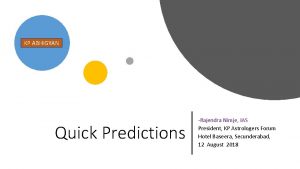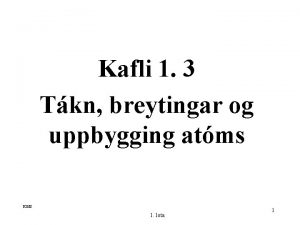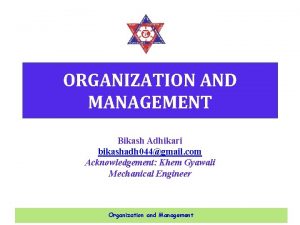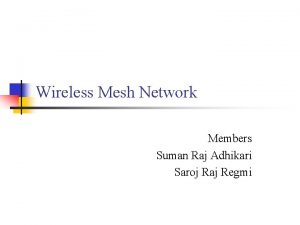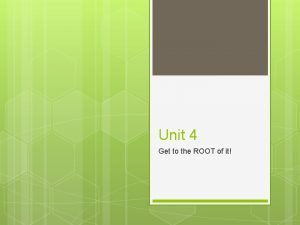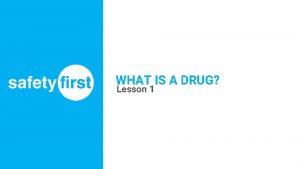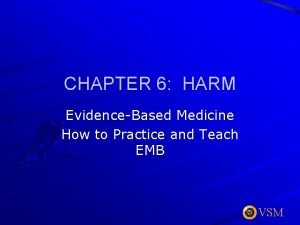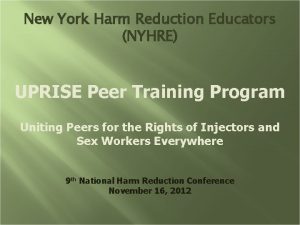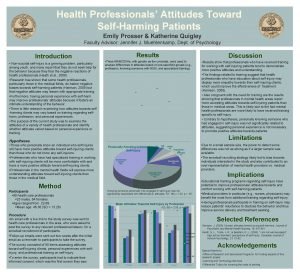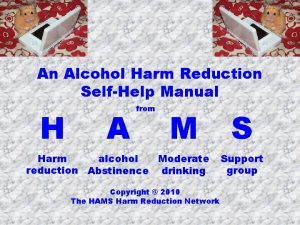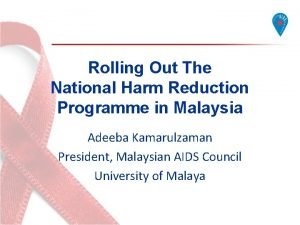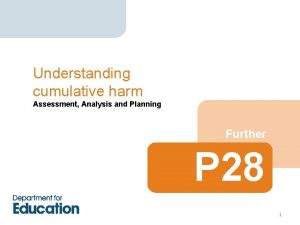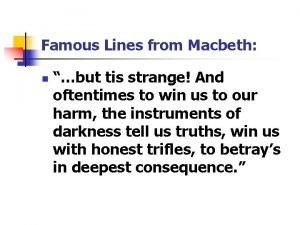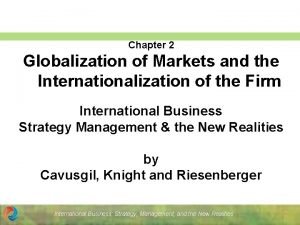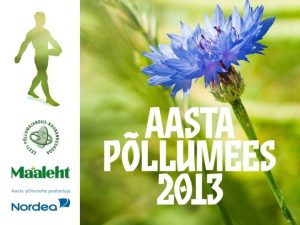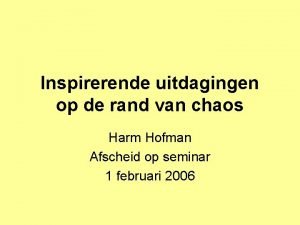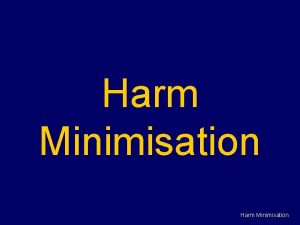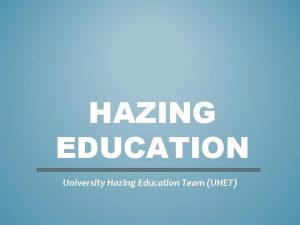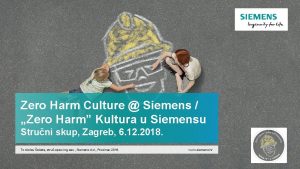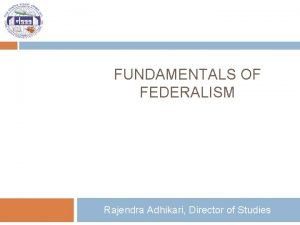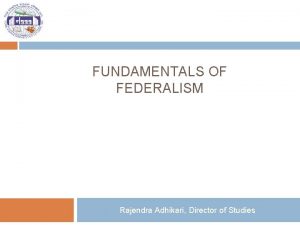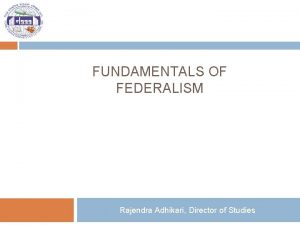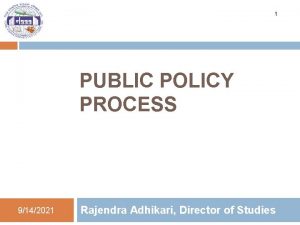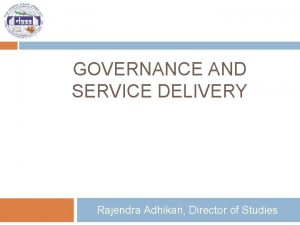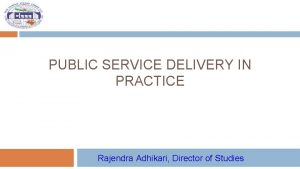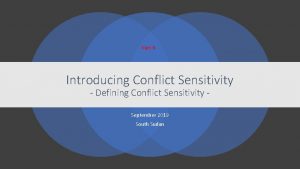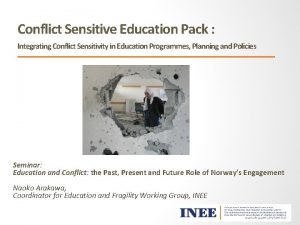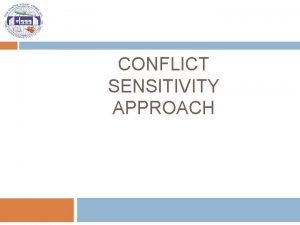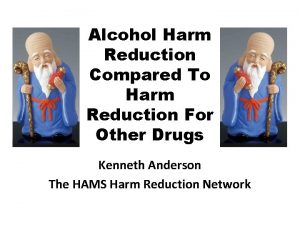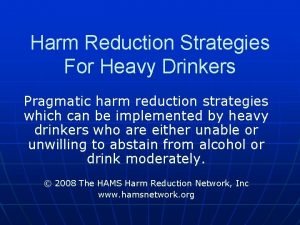CONFLICT SENSITIVITY DO NO HARM Rajendra Adhikari NASC










































- Slides: 42

CONFLICT SENSITIVITY: DO NO HARM Rajendra Adhikari NASC

Outline Understanding conflict and conflict sensitivity Kinds and stages of conflict Tool of CS Analysis: Do No Harm (DNH)

Background 3 “Development is not only affected by conflict – it often has effects on conflict too. ” (Safer World, 2011) radhikari@nasc. org. np 11/22/2020

Definition of conflict Conflict is a social fact in which two parties are involved and: Strive for incompatible goals to begin with Strive for the same goal which can only be reached by one party, and or Want to employ incompatible means to achieve a certain goal. Ulrike C. Wasmuth (1996, 180 -181)

Definition of conflict Working definition: Conflict is defined as a relationship between two or more parties (individuals or groups), who have (in actual) or think they have (perceive), incompatible goals.

Kinds of Conflict superficial conflict open conflict kinds of conflict no conflict latent conflict

Stages of conflict Crisis Confrontatio n Latent conflict Cession of hostilities Post conflict

Conflict and Conflict sensitivity (CS) 8 Conflict: The results of parties disagreeing and acting on the basis of perceived incompatibilities. Conflict Sensitivity is defined as the capacity to: Understand the context in which a project operates Understand the interactions between project and the context Act upon the understanding of this interaction for adjustment radhikari@nasc. org. np 11/22/2020

Conflict Sensitivity Analysis Tools 9 Do No Harm (DNH) radhikari@nasc. org. np 11/22/2020

Do No Harm 10 A simple and widely accepted instrument of CS. It was developed from the experience of development and humanitarian workers. Developed by Mary B. Anderson and Collaborative for Development Action (CDA). radhikari@nasc. org. np 11/22/2020

Seven steps of DNH Framework 11 1. Understanding the context 2. Analyzing dividers or sources of tension 3. Analyzing connectors or local capacities for peace 4. Analyzing the project/assistance programme 5. Analyzing the projects impact on D & C (using RT and IEM) 6. Considering (and generating) programming options 7. Test programming options and redesign project radhikari@nasc. org. np 11/22/2020

Step I: Understanding the context 12 Societies have groups with different interests and identities that contend with other groups. Impacts on the socio-political context that cause, or have the potential to cause, destruction or violence between groups. The three most useful tools are timeline, actor mapping and conflict tree radhikari@nasc. org. np 11/22/2020

Step II: Analyzing dividers or sources of tension 13 • Factors that people are fighting about or cause tension among individuals or groups. radhikari@nasc. org. np 11/22/2020

Different values and interests 14 • Religious values and beliefs • Political values • Social values • Interests of the actual leader or government radhikari@nasc. org. np 11/22/2020

Symbols and special occasion 15 • Flag , colours, festivals and identity-based songs • Religious holidays radhikari@nasc. org. np 11/22/2020

Different experiences 16 • Different lifestyles of those from different regions • Different experiences radhikari@nasc. org. np 11/22/2020

Attitudes and actions 17 • Blaming others but not take one’s own responsibility • Attitude of mistrust and suspicion radhikari@nasc. org. np 11/22/2020

Systems and institutions 18 radhikari@nasc. org. np 11/22/2020 • Social, historical, traditional or legal systems of discrimination, exclusion or dominance in jobs, the education system, access to health facilities • Supply systems which can be controlled by one group.

Step III: Analyzing connectors or local capacities for peace 19 • Factors that bring people together and/or tend to reduce tension among individuals/groups. radhikari@nasc. org. np 11/22/2020

Systems and institutions 20 • Markets • Educational institutions • Infrastructure • Communicati on system • Hospitals • Common village identity radhikari@nasc. org. np 11/22/2020

Attitudes and actions 21 • Nonviolent attitudes and actions even during time of instability • Expression of tolerance, acceptance, love and appreciation for people on ‘the other side’ radhikari@nasc. org. np 11/22/2020

Shared values and interests 22 • Care for children during war • Allowing space for impartial or humanitarian action • Peace zone • Religion radhikari@nasc. org. np 11/22/2020

Common experience 23 • Networking against violence • Sad or traumatic experience of violence radhikari@nasc. org. np 11/22/2020

Symbols and occasions 24 • National festivals • National anthem • Sports radhikari@nasc. org. np 11/22/2020

Step IV: Analyzing the assistance programme 25 Why? Where? What? When? With whom? By whom? How? radhikari@nasc. org. np 11/22/2020

Step V: Analyzing the assistance programme’s impact on D & C (using RT and IEM) 26 Assistance is a vehicle for providing resources to people who need them. Resource transfers The transfers of resources (i. e. money, goods, and services) from one entity to another. Resources in a conflict environment represent wealth and power and thus may become part of the conflict. Implicit ethical messages (IEMs) radhikari@nasc. org. np 11/22/2020

Theft 27 • Assistan ce can be stolen and support conflict efforts radhikari@nasc. org. np 11/22/2020

Market effects 28 • Assistan ce affects prices, wages and profits radhikari@nasc. org. np 11/22/2020

Distributional effects 29 • Assistan ce creates divisions among the populatio n radhikari@nasc. org. np 11/22/2020

Substitution effects 30 • Assistan ce can substitute for local resources radhikari@nasc. org. np 11/22/2020

Legitimization effect 31 • Assistan ce legitimize s some people and actions and weakens or sidelines others. radhikari@nasc. org. np 11/22/2020

Implicit Ethical Messages (IEM) 32 These are the effects of institutional and individual behaviours, actions and attitudes on the context. IEMs are often unrecognized by the providers but could easily be misinterpreted by the recipients. radhikari@nasc. org. np 11/22/2020

33 Competition among assistance agencies: disrespect & mistrust radhikari@nasc. org. np 11/22/2020

Publicity 34 radhikari@nasc. org. np 11/22/2020

Powerlessness 35 radhikari@nasc. org. np 11/22/2020

36 Different values for different lives radhikari@nasc. org. np 11/22/2020

37 Assistance workers and impunity radhikari@nasc. org. np 11/22/2020

Suspicion: Tension 38 radhikari@nasc. org. np 11/22/2020

Arms and powers 39 radhikari@nasc. org. np 11/22/2020

Step VI: Considering (and generating) programming options 40 We must think about how to provide the same programme in a way that eliminates or minimizes its negative, conflict-worsening impacts. If we find that we have overlooked the local peace capacities or connectors then we should redesign our programming in order to strengthen those connectors. radhikari@nasc. org. np 11/22/2020

Step VII: Test programming options and redesign project 41 Once we have selected better programming options based on the previous exercise, it is crucial to re-check the impacts of our new approach on the dividers and connectors. radhikari@nasc. org. np 11/22/2020

Conclusion 42 Let’s act conflict sensitively. radhikari@nasc. org. np 11/22/2020
 Astrologersforum
Astrologersforum Dr rajendra shrestha
Dr rajendra shrestha Introduction to angular
Introduction to angular Pramod adhikari
Pramod adhikari Vertical
Vertical Saroj raj adhikari
Saroj raj adhikari Respect root word
Respect root word Tg20 compliance sheet
Tg20 compliance sheet Prin ce se înmulțesc animalele
Prin ce se înmulțesc animalele Tg scaffolding
Tg scaffolding Viv root meaning
Viv root meaning External conflict
External conflict What is conflict and conflict resolution?
What is conflict and conflict resolution? Internal conflict definition and examples
Internal conflict definition and examples Node of ranvier channels
Node of ranvier channels Harm reduction strategies
Harm reduction strategies Malapropism
Malapropism Number needed to harm
Number needed to harm New york harm reduction educators
New york harm reduction educators Abh vs gbh
Abh vs gbh Emily self harm
Emily self harm Every time
Every time Being legally responsible for causing harm is
Being legally responsible for causing harm is Harm reduction worksheets
Harm reduction worksheets Harm reduction programme
Harm reduction programme Fishermen in the cold sea would not harm
Fishermen in the cold sea would not harm Harm knolle
Harm knolle Cumulative harm
Cumulative harm Number needed to treat calculation
Number needed to treat calculation Famous lines from macbeth
Famous lines from macbeth Free from harm report
Free from harm report For internationalizing firms the consequences
For internationalizing firms the consequences Ain aasa
Ain aasa Harm hofman
Harm hofman Harm reduction
Harm reduction Principles of harm minimisation
Principles of harm minimisation Hidden harm hazing
Hidden harm hazing Joanna self harm
Joanna self harm Zero harm
Zero harm Clinical harm review
Clinical harm review Where does beowulf see a tremendous sword
Where does beowulf see a tremendous sword Self harm toolkit essex
Self harm toolkit essex How to calculate number needed to treat
How to calculate number needed to treat
